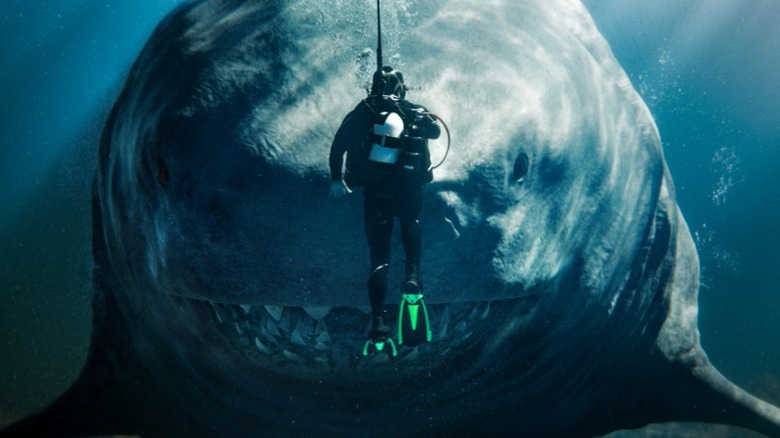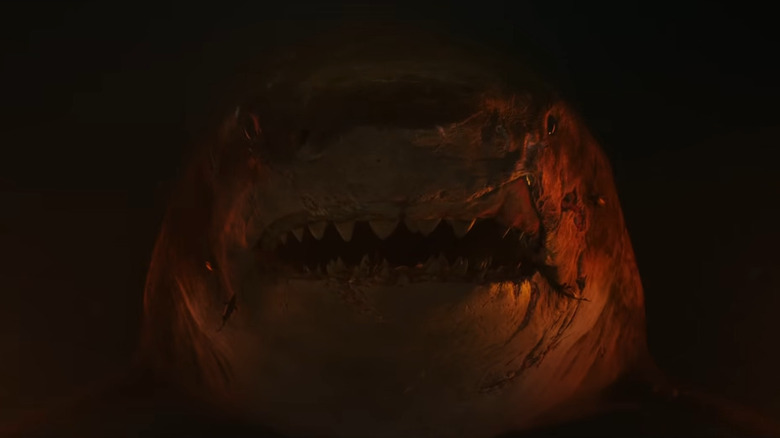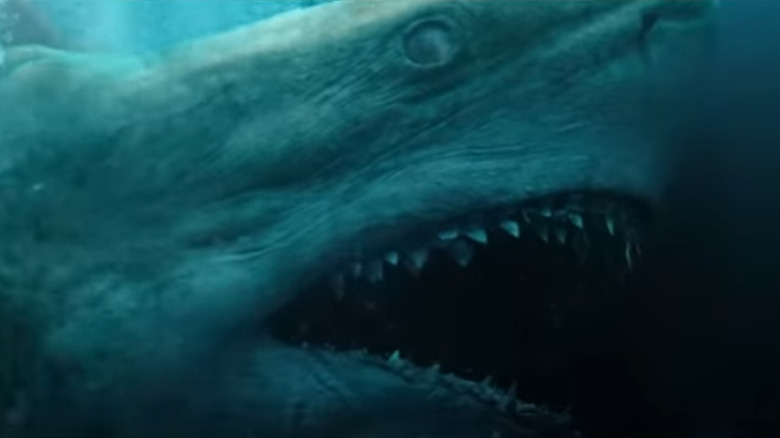Meg 2: What Were Megalodons Like In Real Life?
We have always been fascinated with the predators that have inhabited our planet from the earliest pre-historic times until now. From flocking to the theaters to watch "Jurassic Park" to tuning in to "Shark Week," our love of an apex predator is unquenchable. These days, one of our biggest fascinations is with the long-extinct Megalodon thanks in no small part to "The Meg" and its recently released sequel, "Meg 2: The Trench." When it comes to cinematic sharks, fact and fiction often get intertwined, and in the case of the now-infamous Megalodon, these deep-sea alphas are nothing like they've been depicted.
Thanks to the massive success of "Jaws" a half-century ago, sharks have become some of the most feared (and perhaps the most misunderstood) animals on the planet. They are often seen as vicious predators of the open sea that will eat any human in the vicinity if given the chance. Movies like "Deep Blue Sea," "Open Water," "The Shallows," and even "Sharknado" have done nothing but reinforce our fear of the animals, and Megalodons are now getting the same big-screen reputation.
But fish fossil curator Emma Bernard has set the record straight in a piece for Great Britain's Natural History Museum, separating the fiction of "The Meg" and the historical fact of what these animals were really like (to the best of our knowledge).
Were Megalodons actually vicious predators?
Were Megalodons the vicious predators in real-life that we see on the screen? In a sense, yes. But it is more complicated than that when taken in the context of the representation on screen. In her interview about the pre-historic sharks, Emma Bernard says, "With its large serrated teeth, Megalodon would have eaten meat – most likely whales and large fish, and probably other sharks. If you are that big, you need to eat a lot of food, so large prey is required." This means that chasing after and eating humans would do the Megalodon no good if they were around today.
The Natural History Museum piece goes on to say that there is other evidence that Megalodons ate larger sea animals in the form of fossilized whale bones with the tips of the giant Megalodon teeth broken off inside. While the giant predator thirsting for human blood is excellent fodder for a Jason Statham action vehicle, the reality is Megalodon would likely have little interest in humans.
"Meg 2: The Trench" portrays the Megalodon as a 75-foot terror that is eating people at every turn, but the reality is that it was likely closer to 60 feet (still three times longer than the largest Great White). Of course, if there is no other available food, the shark would need to constantly eat as many humans as possible to get enough sustenance. But the reality is that the Megalodon would likely search for larger sea animals instead of feasting on a small collection of humans at the beach. That makes them similar to another misunderstood animal, the snake. While we fear them, we are not a part of their food chain, and therefore they have little interest.
What did the Megalodon look like and where did they go?
Thanks to movies like "The Meg," we have an image that the Megalodon is a larger version of the great white shark from "Jaws." Since that image is burned into our collective psyche as the most dangerous thing beneath the waves, creating something three times the size is great for cinematic scares. In actuality, Emma Bernard says they aren't even related. "A lot of reconstructions have Megalodon looking like a bigger version of the great white shark because, for a long time, people thought they were related," she explained. "We now know that this is not the case, and Megalodon is actually from a different lineage of shark of which Megalodon was the last member." Bernard further explained that they likely had shorter noses and larger pectoral fins, like the blue shark, to support their size.
Here is where "The Meg" version of the prehistoric animal falls apart completely. Bernard noted that the Megalodon likely went extinct due to the cooling of the oceans, causing a loss of its habitat. They were adapted to live in tropical waters, which put them off the coast of North America in the Caribbean. She also assured everyone that if Megalodons were still around, we would have seen evidence by now.
So while unintentionally releasing a pack (herd? gaggle?) of sharks from the deep trench is a lovely setup for a Jason Statham movie, the odds of that happening in real life are slim. In any case, it's still fun to watch.


